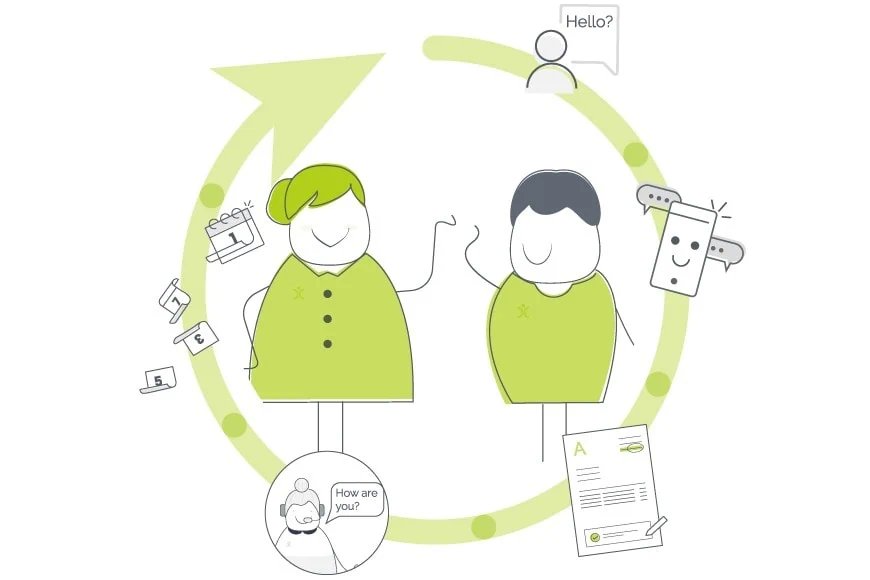How to Perfect Your Sales Cycle
24 Oct 2022
(Republished from an earlier article)
Your business’ sales cycle is everything. From how you handle that initial contact with a new prospect. To signing the sales off. All the way through to aftercare and customer engagement.
But every business’ sales cycle is different…so how am I going to give you advice on perfecting it? And who am I to tell you about perfecting your sales cycle?
I’ve been a salesman since I stumbled into it in my early twenties. I’d been a professional musician, traveling around Europe, having the time of my life. Then I had my first child and realised that I really needed something a little more stable…with a little bit less traveling around in a smelly old van.
And then I managed to basically talk myself into a sales job.
That encounter not only proved to me the value of making a real, human connection when securing an opportunity, but also that I was actually pretty good at this whole talking malarky. Maybe not the writing so much.
Anyway.
Every business has different requirements from its sales cycle. After all, the sale of a book is very different from that of a ten-user CRM system with a complex permissions model and customisation requirements.
But in my experience, every sales cycle will have three general phases, even if the steps and processes with those phases may differ greatly.
The three (general) phases of the sales cycle are: building a relationship, securing the sale, and aftercare.
I’d like to share with you my top tips for how you can:
- identify the elements of each of these phases,
- monitor how well these various steps within each phase are performing, and
- work towards improving both the individual steps and (therefore) your sales cycle as a whole.

Don't just take our word for it
Click to read how other companies have benefited from using OpenCRM. From out-of-the-box implementations to businesses that needed bespoke development to fit their unique approach - we've seen it all.
find out morePhase 1: Making First Contact
This is the first part of any business’ sales cycle, in one way or another. And one that takes real skill from the salesperson. I’m not including the more traditional step of attracting a lead, as that falls more into the marketing cycle in my mind.
What are some common steps that make up this phase?
For many businesses, this will be the shortest phase of the sales cycle. But it is an important one for each individual salesperson to get right.
This first contact could be an automated email after someone fills out a form on your website. Maybe with a follow-up call the next day. Or it could start with an inbound call or chat.
The steps that characterise this phase are:
- Managing Lead acquisition
- Relationship building and nurturing
- Assessing the prospects requirements
How can you measure success here?
One of the commonly used benchmarks for measuring the success of this phase is a comparison of how many people you make contact with vs how many people go on to the next phase.
This is known as a conversion rate. In the CRM, this is often characterised by the movement of a record for the prospect (Lead) into another area of the system (Contacts and Companies).
The decision for when to do this is very much dependent on your business’ sales funnel.
You may leave the person as a Lead in your system for a number of weeks. Building the relationship until you have a better feel for the likelihood of the sale.
Alternatively, you may convert your Leads after the very first phone call, for example, safe in the knowledge that you speaking to this person gives you a good chance of winning the sale.
If that is the case, you would probably want to use your Opportunity sales stages to track your success rate. So if an Opportunity moves from the “nurturing” stage to the “negotiation” stage, you know you’ve succeeded in this phase.
As with any other part of your business, the way you manage the success of the various phases of your sales cycle is unique.
So how do you make this first phase of your sales cycle a success?
In a word: listen.
Yes, the person has got in touch to find out what you can do for them, but until you know what their pain points are, you can’t do anything for them.
We’ve all been in that sales conversation where the sales rep is so keen to finish the ‘elevator pitch’ that they don’t even give you time to tell them why you’re calling.
Following on from that, make room in your sales cycle for that bit of back-and-forth chatter. It might seem like those two-line emails of (what you see as) basic questions are stretching out your cycle, making it longer and less efficient than it could be.
Remember that this part of the sales cycle is all about your sales team earning your prospect’s trust. They want to give you their money, but they aren’t going to part with it until they’re sure you’re going to deliver on your promises.
So my advice:
Don’t get caught up in your own script. Listen to what they have to say and tailor your responses to that. Get to know the person, it will pay dividends in the long run.

Let us take you on a tour
You've had a look around and are starting to think OpenCRM might be the system for you and your business. Why not chat with one of our team (and ask your burning CRM questions) as they take you on a tour of the system?
find out morePhase 2: the Deal
Ah, the chase. The thing that gets a salesperson out of bed in the morning.
Ok, that might be a stretch, but this is the part of your sales cycle that most people think is the ONLY part of the sales cycle.
The steps on the path toward the sale
This aspect of the sales cycle is often known as the pipeline and, like everything, varies widely between businesses…even ones in the same industry.
In broad brush strokes, it includes steps like:
- Identifying client needs
- Outlining bespoke changes
- Price negotiations
- And so on
These steps will be intrinsically tied to what your business sells and your pricing model.
Measuring success here isn’t as obvious as you might think
Ok ok, I know…the main measurement here is the revenue generated…but that’s not the end of the story.
In our line of work (CRM), it’s the thing that actually brings us most of our business: managers are desperate to know what their sales team is up to during the actual selling process.
They want to see how often negotiations go up and down in value, how much time is spent on Opportunities before they close, which salesperson is selling the most, and on and on.
It’s not just about the revenue is what I’m getting at…it’s about the time and energy put into winning the deal as well.
What do you do when this phase looks in trouble?
They’re about to sign on the dotted line, you’re ready to kick start the delivery process, but then…nothing. Or maybe a few more delays, a few more questions.
Every salesperson has encountered it…you think the deal is ready to drop, but something is just holding them up at the other end of the phone.
This is where all that goodwill you built up in the last stage of your sales cycle really comes into play. It’s also where having a system like OpenCRM can be really useful.
Let me explain what I mean:
CRM systems are great for keeping track of all that data you hold on your prospects and customers. They’re also great for automation and keeping a sales process moving.
Having some reminders and auto-emails set up to let both you and your prospect know when a quote is ready to expire or when an offer is going to run out can hurry along that last stage of your sales cycle (if someone is dragging their feet).
Being able to send those emails or make that follow-up call to someone who you have a relationship with will soften the blow.
So my advice for closing the deal?
Combine the tools at your disposal and the relationship you’ve built to ensure you can ask for the business without damaging that relationship.

Do we have what it takes?
We don't restrict which features you have access to in OpenCRM based on how many users you have. You get everything right out of the box. Click to find out if we've got the features you need.
find out morePhase 3: Keeping them Happy
And the reason you want to keep that relationship intact? They’re going to be your customer. You want them to still like you after the sale is over.
Now you personally might not be doing the account management or customer support down the road, but your colleagues will be. Building and maintaining a good relationship with your customers is key to improving customer retention.
Really, when you think about it, it’s really about perfecting the final stage of your sales cycle.
Last steps in the sales cycle
You’ve sent the invoice, the product or service is being delivered…are there any other steps?
Of course there are!
This aftercare can include:
- Customer and technical support
- Email marketing for future sales campaigns
- Referral programs
- Social media engagement
- And all those other things you do (or want to do) with your customers
Essentially, the last steps in the sales cycle are carried out in the hopes that your existing customers will re-enter the cycle and give you some more business. And hopefully, bring some of their friends along.
Can you even measure happiness?
There are so many different ways to measure how happy your existing customers are with the service you provide.
From the very direct things like sending out customer satisfaction surveys or reporting on repeat business as a separate revenue stream.
But there are other, softer ways to measure how happy your customers are, things like click-throughs and social media engagement.
Bundling the direct and indirect means of measuring this aspect of your sales cycle will tell you how successful you are at it…and show you where you can improve.
Tips for improving customer relationship (management)
The final stage of your sales cycle isn’t closing the deal or even securing payment. It’s preparing them for their lifetime as your customer — which we all hope is going to be a good number of years.
And now my last bit of advice?
Remember that your sales cycle never really ends. This “new” customer will become a recurring customer if you play your cards right.
Every business has its own sales cycle and their own way of managing each stage of it. The tips I’ve relayed, however, have served me well over the years, in a variety of industries.
The perfect sales cycle revolves around keeping your prospect happy and fulfilling their needs, without bankrupting your business. It has to serve both parties…but in my experience, a sales cycle that builds a good relationship with your leads and customers is the best foundation your business can have.
Before I got my start in the tech industry as part of Apple’s UK Mac launch team, I was a professional drummer (notice I didn’t say musician). But once I got in, I was hooked and I’ve been involved in the tech industry, primarily software development, for over 35 years. I founded this company and I now have the enviable title of System Architect (as well as Managing Director) here at OpenCRM.